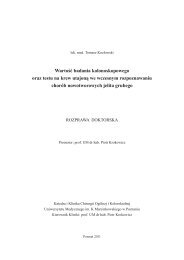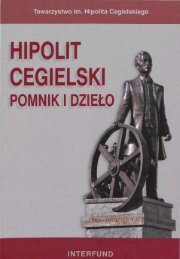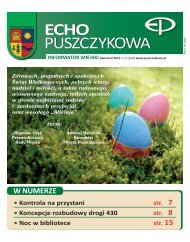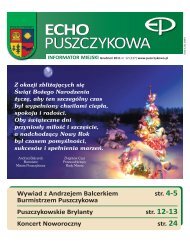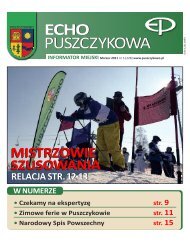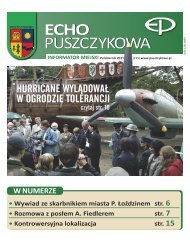MILITARY PHARMACY AND MEDICINE
MILITARY PHARMACY AND MEDICINE
MILITARY PHARMACY AND MEDICINE
Create successful ePaper yourself
Turn your PDF publications into a flip-book with our unique Google optimized e-Paper software.
© Military Pharmacy and Medicine • 2012 • 4 • 73 – 762) reactions in patients with severe asthma orstrong asthmatic component,3) reactions associated with the possibility ofcontinuous exposure to the allergen,4) patients who underwent biphasic reactionsin the past.If there is bronchospasm not responding to standardmanagement, inhalation of beta-2 receptorantagonist, e.g. salbutamol, may be of some help.Additional tests and further managementMeasuring mast cell tryptase levels can retrospectivelyfacilitate the diagnosis of anaphylaxis.Ten milliliters of blood should be drawn to a tubecontaining clot activator between 45 minutes to 6hours after the episode.Radosław Ziemba: Cardiac arrest under special … Part II: poisoning …Cardiac arrest in patients with severe asthmamay occur as a result of:1) hypoxia due to severe bronchospasm andairway obstruction by secretions;2) arrhythmias due to hypoxia or beta receptoragonist and aminophylline toxicity;3) tension pneumothorax.Life-threatening asthmatic episode is recognizedbased on the absence of breath sounds, cyanosisand poor respiratory drive. It may be accompaniedby bradycardia and hypotension. Patientappears exhausted, confused or falls into a coma.Arterial blood gas measurement reveals hypoxia,acidosis accompanied by normal or elevated carbondioxide partial pressures.Acute managementFollowing successful management of anaphylacticreaction, it is important to identify the allergenin order to avoid recurrence of the conditionin the future. Therefore, patient should bereferred to a specialist outpatient clinic. Patientsat great risk of anaphylactic reaction can keep atall times a special, adrenaline-filled syringe forself-administration and wear a warning bracelet.Acute episode of severe asthmaAcute episode of severe asthma is almost alwaysa reversible state and we must assume that suchpatients can be saved. The majority of deathsoccur outside of the hospital. Several factors contributeto it, such as:1) patient and his relatives do not recognizethe severity of asthmatic episode and turn tomedical help too late;2) emergency services and family doctors donot always act fast enough;3) patients with mild asthmatic episodes aredischarged home after being provided withmedical assistance and suffer from suddendeterioration of their condition.It is important to treat all asthmatic exacerbationsaggressively in order to prevent futurelife-threatening recurrences and cardiac arrest.National guidelines were published on managementof acute asthma exacerbations based onearly oxygen administration, use of beta-2 receptorblockers (salbutamol), corticosteroids andaminophylline.http://military.isl-journals.comPatient status will quickly deteriorate, leading torespiratory arrest and secondary cardiac arrestif proper management is not immediately commenced.Such patient should be quickly movedto a facility where proper care and monitoringis available. High oxygen concentrations areadministered. First-line therapy in acute asthmais inhalation of beta-2 agonists. It usually beginswith administration of salbutamol (5 mg in 5 mlof saline) in nebulization mixed with oxygen, orin 4-6 puffs using an inhaler with a spacer. Thisdose can be repeated at 15-minute intervals or,if necessary, it can be administered continuously.Corticosteroid therapy should be commenced atan early stage (during first 30 minutes). Prednisoloneat a dose of 30-60 mg orally, 200 mg ofhydrocortisone i.v. or both drugs should be givenif patient’s condition is very severe.If this treatment gives no effects, subcutaneousadministration of adrenaline (0.3 mg) can preventthe necessity of artificial ventilation. Thesame dose of adrenaline (0.3 mg) can be repeatedtwice in 20-minute intervals.If drugs administered so far are not effective,other actions are taken such as: inhalations withanticholinergic drugs (ipratropium 0.5 mg innebulization), intravenous infusion of aminophylline(5 mg/kg infusion in 30-45 minutes),intravenous magnesium sulfate (2-3g) or administrationof a breathing mixture containinghelium and oxygen in a 70:30 ratio. Performingchest x-ray examination early is instrumental.73



